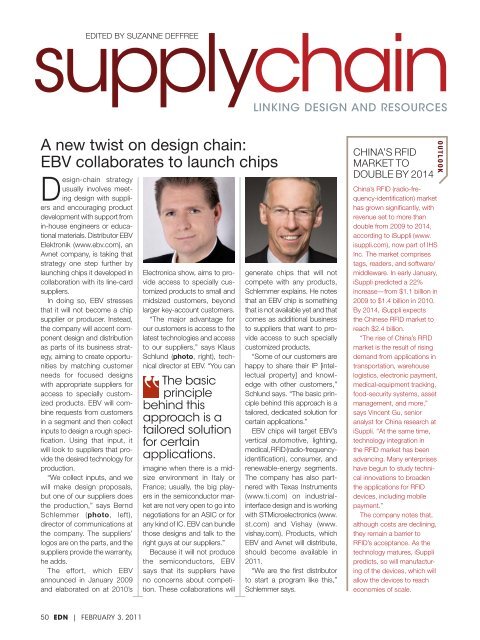VOICE OF THE ENGINEER - ElectronicsAndBooks
VOICE OF THE ENGINEER - ElectronicsAndBooks
VOICE OF THE ENGINEER - ElectronicsAndBooks
- No tags were found...
You also want an ePaper? Increase the reach of your titles
YUMPU automatically turns print PDFs into web optimized ePapers that Google loves.
supplychainEDITED BY SUZANNE DEFFREELINKING DESIGN AND RESOURCESA new twist on design chain:EBV collaborates to launch chipsDesign-chain strategyusually involves meetingdesign with suppliersand encouraging productdevelopment with support fromin-house engineers or educationalmaterials. Distributor EBVElektronik (www.ebv.com), anAvnet company, is taking thatstrategy one step further bylaunching chips it developed incollaboration with its line-cardsuppliers.In doing so, EBV stressesthat it will not become a chipsupplier or producer. Instead,the company will accent componentdesign and distributionas parts of its business strategy,aiming to create opportunitiesby matching customerneeds for focused designswith appropriate suppliers foraccess to specially customizedproducts. EBV will combinerequests from customersin a segment and then collectinputs to design a rough specification.Using that input, itwill look to suppliers that providethe desired technology forproduction.“We collect inputs, and wewill make design proposals,but one of our suppliers doesthe production,” says BerndSchlemmer (photo, left),director of communications atthe company. The suppliers’logos are on the parts, and thesuppliers provide the warranty,he adds.The effort, which EBVannounced in January 2009and elaborated on at 2010’sElectronica show, aims to provideaccess to specially customizedproducts to small andmidsized customers, beyondlarger key-account customers.“The major advantage forour customers is access to thelatest technologies and accessto our suppliers,” says KlausSchlund (photo, right), technicaldirector at EBV. “You canThe basicprinciplebehind thisapproach is atailored solutionfor certainapplications.imagine when there is a midsizeenvironment in Italy orFrance; usually, the big playersin the semiconductor marketare not very open to go intonegotiations for an ASIC or forany kind of IC. EBV can bundlethose designs and talk to theright guys at our suppliers.”Because it will not producethe semiconductors, EBVsays that its suppliers haveno concerns about competition.These collaborations willgenerate chips that will notcompete with any products,Schlemmer explains. He notesthat an EBV chip is somethingthat is not available yet and thatcomes as additional businessto suppliers that want to provideaccess to such speciallycustomized products.“Some of our customers arehappy to share their IP [intellectualproperty] and knowledgewith other customers,”Schlund says. “The basic principlebehind this approach is atailored, dedicated solution forcertain applications.”EBV chips will target EBV’svertical automotive, lighting,medical, RFID (radio-frequencyidentification), consumer, andrenewable-energy segments.The company has also partneredwith Texas Instruments(www.ti.com) on industrialinterfacedesign and is workingwith STMicroelectronics (www.st.com) and Vishay (www.vishay.com). Products, whichEBV and Avnet will distribute,should become available in2011.“We are the fi rst distributorto start a program like this,”Schlemmer says.CHINA’S RFIDMARKET TODOUBLE BY 2014China’s RFID (radio-frequency-identification) markethas grown signifi cantly, withrevenue set to more thandouble from 2009 to 2014,according to iSuppli (www.isuppli.com), now part of IHSInc. The market comprisestags, readers, and software/middleware. In early January,iSuppli predicted a 22%increase—from $1.1 billion in2009 to $1.4 billion in 2010.By 2014, iSuppli expectsthe Chinese RFID market toreach $2.4 billion.“The rise of China’s RFIDmarket is the result of risingdemand from applications intransportation, warehouselogistics, electronic payment,medical-equipment tracking,food-security systems, assetmanagement, and more,”says Vincent Gu, senioranalyst for China research atiSuppli. “At the same time,technology integration inthe RFID market has beenadvancing. Many enterpriseshave begun to study technicalinnovations to broadenthe applications for RFIDdevices, including mobilepayment.”The company notes that,although costs are declining,they remain a barrier toRFID’s acceptance. As thetechnology matures, iSupplipredicts, so will manufacturingof the devices, which willallow the devices to reacheconomies of scale.OUTLOOK50 EDN | FEBRUARY 3, 2011






![[270].pdf 37407KB Sep 02 2010 09:55:57 AM - ElectronicsAndBooks](https://img.yumpu.com/50350834/1/185x260/270pdf-37407kb-sep-02-2010-095557-am-electronicsandbooks.jpg?quality=85)
![draaien, A Viruly 1935 OCR c20130324 [320]. - ElectronicsAndBooks](https://img.yumpu.com/49957773/1/190x252/draaien-a-viruly-1935-ocr-c20130324-320-electronicsandbooks.jpg?quality=85)



![20051110 c20051031 [105].pdf 35001KB Feb 18 2009 08:46:32 PM](https://img.yumpu.com/48687202/1/190x253/20051110-c20051031-105pdf-35001kb-feb-18-2009-084632-pm.jpg?quality=85)




